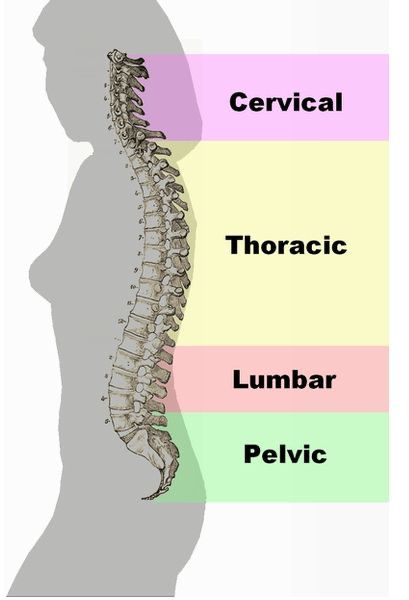Back pain - structure of your spine
Back pain & injuries
About your back and the parts can cause pain
Structure of your spine
The bones in your spine are called your vertebrae, and you have 33 of them in your spinal column.
Your spine is divided into five regions, each with their own characteristics:
- Cervical spine: The vertebrae in your neck are labeled C1-C7, meaning that you have seven vertebrae in that region.
- Thoracic spine: Most adults have 12 vertebrae in the thoracic spine (T1-T12), which goes from your shoulders to your waist.
- Lumbar spine: There are five vertebrae in your low back (L1-L5).
- Sacrum: Your sacrum is made up of five vertebrae between the hipbones that are fused into one bone
- Coccyx:. The coccyx is small fused bones at the very tail of your spine


The intervertebral discs
Between each of your vertebrae, you have intervertebral discs. These act like pads or shock absorbers for your spine as it moves.
Each disc is made up of a tire-like outer band called the annulus fibrosus and a gel-like inner substance called the nucleus pulposus.
The process of aging changes the discs and makes them less able to cushion your movements. As you get older, your intervertebral discs also become more prone to problems; they may bulge or herniate.
Together, the vertebrae and the discs provide a protective tunnel (the spinal canal) to house the spinal cord and spinal nerves.
These nerves run down the center of the vertebrae and exit to various parts of the body, where they help you feel and move. You can see the spinal cord running through the vertebrae in the image.

The facet joints
Your spine also has facet joints (also called apophyseal joints), which are on the posterior side (back) of your vertebrae. These joints (like all joints in your body) help facilitate movement and are very important to your flexibility.
The joint surfaces are covered by cartilage, which protects your bones as you move.
Without cartilage, your bones would rub together - this is very painful.
The joint is surrounded by the joint capsule, which is lined with synovial membrane, and bathed in synovial fluid. The joint capsule and synovial membrane contain a lot of blood vessels and nerves. Movement of the synovial membrane promotes the production of synovial fluid.
Cartilage gets most of its nutrition from the synovial fluid and therefore movement of the joints is essential to the health of the cartilage.
The joint is surrounded by ligaments. Ligaments are the strong, flexible bands of fibrous tissue that link bones together. They contain a lot of nerve endings and so that your body knows what each joint is doing all the time. This is called proprioception.
Muscles of the back
Your back also has muscles, tendons, and blood vessels.
Muscles are strands of tissues that power your movement and tendons connect muscles to bones.
They also contain lots of nerve endings to tell your body how stretched or contracted or tired each muscle is at any time. When we ignore warning signs from these nerve receptors, we risk injury.
Blood vessels provide nourishment to all these structures. The arteries and arterioles (mini arteries) carry oxygen attached to your red blood cells, glucose and salt-rich fluids to provide nutrition, white blood cells and platelets to repair damage.
The venules (mini veins) and veins carry away waste products included drained red blood cells, rubbish-laden white blood cells and fluids containing metabolic waste products including lactic acids.

When muscles are tight or tissues are inflamed through injury or disease, the blood vessels can also be damaged or impeded. This reduces their effectiveness to provide nutrition and drainage of waste products form the area and can further exacerbate the problem.
All these parts of your spine work together to help you move. When one part is injured, the resulting tension or instability will affect all the other structures. Strength and stability of the arms and legs also depend on stability of the back and trunk of the body to provide a firm base of support
- when your back is injured or weak, your arms and legs do not have a stable base from which to function.
How your osteopath can help
Your osteopath can assess your whole spine and determine the cause of your pain or dysfunction. They will explain what is going on and what the best course of action is - either further investigations, i.e. blood tests or X-rays, or a treatment protocol.
The treatment usually consists of mobilisations and/or manipulations to improve mobility and restore good neurological balance alongside remedial exercises to build strength and stability.